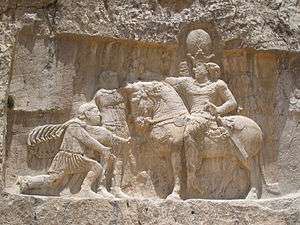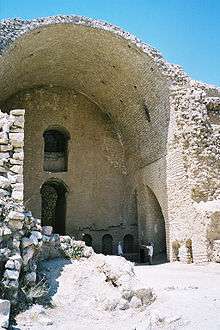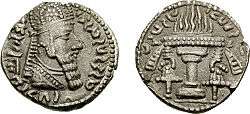Sasanian art

The term Sasanian art, or Sassanid art is the period of Persian art under the Sasanian dynasty of Iran which ruled from the 3rd to 7th centuries AD.
In 224 AD, the last Parthian king was defeated by Ardashir I. The resulting Sassanid dynasty would last for four hundred years, and was brought to an end as a result of the Islamic expansion of the mid-7th century. It began a new era in Iran and Mesopotamia, which in many ways was built on Achaemenid traditions, including the art of the period. Nevertheless there were also other influences on art of the period that came from as far as the Mediterranean.
General
The art of the Sassanids is mainly characterized by its architecture, reliefs and toreutics. There are also outstanding achievements in carvings and paintings. Free standing sculptures faded out of popularity in this time as compared to the period under the Parthians.
Sassanid art depicts very courtly and chivalric scenes. The images of rulers dominates many of the surviving works. Hunting and battle scenes enjoyed a special popularity. Representations are often arranged like a coat of arms, which in turn may have had a strong influence on the production of art in Europe and East Asia. Although Parthian art preferred the front view, the narrative representations of the Sassanian art often features figures shown in the profile or a three-quarter view. Frontal views occur less frequently.
Sculptures

Reliefs


Some of the greatest achievements are mainly a series of more than thirty rock relief monuments. They are mostly found in Fars Province, which was the original province of the ruling Sassanid house. The reliefs mostly date back to between the 3rd and beginning of the 4th centuries. The reliefs depict some significant event and are usually attributed to specific rulers.
A relief at Naqsh-e Rustam is mounted below the Achaemenid royal tombs, and is therefore probably in reference to this, as a way for a monarch to likein and connect himself to the old dynasty and pay homage. Ardashir I is depicted with the god Ahura Mazda, each in strict profile and of the same size. This depicts an equality of the monarch and the god, indicating a greatness about him. The relief is modeled very strong, but is rather cautious in the presentation of details. There is evidence of Hellenistic influences in the relief.
Other reliefs, such as at Taq-e Bostan, are mounted in a rock-hewn arch. On the back wall of this there are almost fully sculpted figures. Khosrau II is illustrated on a horse in a heavy suit of armor. The scenes on the sides of this show a royal hunt. The figure of the ruler is shown in front view, his face contrast in three-quarter view. His figure is tall and dominates the whole scene, other figures, however, are shown comparatively small. The composition gives the representation of landscape and many details such as the court of the king, a rather picturesque impression and was certainly once painted.
Stucco
In addition to the rock reliefs, stucco reliefs played a major role in art under the Sassanids. Since stone brick buildings were conceived as ugly, they were covered in stucco. Within these stucco walls reliefs were often carved of mainly floral patterns, but also figurative representations and especially animals. Often important state buildings, such as palaces and administrative headquearers, would have been decorated as such, often colored white. The practice of such was probably adopted to rival the same custom from the Greco-Roman world, despite that at the time Rome and Sassanid Persia were rivals.
Paintings
Paintings played a substantial role in Sassanid art, although it is currently poorly documented. Mani was known to have founded a painting school in his time. In Hajiabad a mansion in Iran was excavated, that still contained well-preserved paintings. The walls were decorated with frontal view busts.[1]
Mosaics

Remarkably, there are a number of mosaics at Bishapur still intact, which were made in a classic style and were apparently made by artists from the Mediterranean.[2]
Architecture

Palaces
Sassanid architecture was mainly characterized by its generously sized to gigantic sized buildings with wide-reaching, high halls.
Under the Sassanids, the arches developed by the Parthians were further pursued. There is usually a large opening to one side of the hall. There is a hall that does not necessarily constitute an enclosed space, but no open courtyard is present and it is usually covered by a vault.
The most famous and impressive examples of Sassanian architecture are the partially standing royal palaces of today. The Palace of Firuzabad (Iran) was built by Ardashir I. It is located on a small lake, which opens to the main arch of the structure. From that opening on both sides slightly smaller halls present are also curved. Behind the main arch is also a hall with a dome 22-meters high., with two domed rooms on either side. Behind these rooms, there is a surrounding courtyard which connects all around. The walls of the rooms are divided by niches and once had rich stucco decorations. The area around the palace was once a garden. The garden, palace, and lake were all built together and were at a time connected.[3]
The palace at Ctesiphon is also dominated by an arch, whose vault is still standing and is one of the largest. The face of the palace walls is elaborately articulated with niches, which once bore paintings and reliefs.
Urban planning
The Sassanids built numerous new cities during their dynasty with elaborate planning. Many of them are circular, mainly as a defensive tactical advantage it had during sieges. The walls of a round city could enclose with the same length of a larger area. But there were also rectangular-scale urban systems. These are usually associated with Roman architects who were abducted by the Sassanids. Although this was probably needed for the planning of these cities in the Sassanid style. Rectangular city facilities are therefore considered as an alternative Sasanian urban planning system.
Firuzabad is a settlement built under Ardashir I and a well-documented example of Sasanian urban planning. The city had a diameter of 2 km and was circular. Two roads divided them into four districts, which in turn were divided into 5 smaller sectors and thus ordered the entire city in 20 sectors. The detailed planning seems to have continued in the surrounding landscape. Bishapur and Gundeshapur, however, are conversely perpendicular cities. Bishapur seems to have been developed by Roman craftsmen, since the local palace is decorated with mosaics in the Hellenistic style.
Coinage


Coins are a particularly important source for a major reason; they are easily datable from all periods of the Sassanid period. Using the name of the ruler's image on the coin in Pahlavi and it can be used to date other works of art. The front usually shows the image of the ruler, sometimes together with a son or wife, rarely with both. On the back there are several scenes, including an investiture or an altar, on which the eternal fire is burning. The tradition of these designs begins with the rather stiff image of Ardashir I (224-242), and under Shapur I (240–270). Under Shapur II (310–379), it is again made of the same material, while the detail modeling is slightly decreased. This is, however, important again later. In the following period the designs are often highly stylized and have been partially recorded.
Arts and crafts
Metalwork
A special feature of Sassanid art is represented by shells of silver and gold, on the inner surface of which a scene is etched into a relief. About a hundred specimens are known of, which demonstrate the literary splendor of the court. Many come from excavations, but they are mostly chance finds. Many were found near the Ural Mountains in Russia and were likely traded in this area. The original purpose, function and authority of these shells therefore remains in the dark. Often, a ruler is shown at the hunt. He usually sits on a horse that moves in a flying gallop. He stands with his sword pointed at a dangerous animal such as a boar or lion or shooting a bow and arrow. The face often appears in three-quarter view.[4]
There are also some peaceful representations that occur, such as depictions of animals and fantasy creatures. Earlier versions of the silver shell bowls usually depict a monarch in full relief, dominating the entire shell. Later,however, in the 4th and 5th centuries the focal character of the shell shares space with a smaller secondary character or element.
Another group of metal goods are present; richly decorated vessels whose shape may have been adopted from the customs of the Mediterranean.
Textiles
There are indications that especially colorful decorated fabrics had a special importance under the Sassanids. However, the assessment of this art form presents many difficulties for the research, as there are few textiles that date back to the Sassanid Empire itself and the findings outside the empire (e.g. in Egypt) are not always of clear origin, if it was imported from the Sassanids or their own imitations or creations. Especially when the textiles are decorated with heraldic animal patterns, a Sassanid origin is usually assumed. Typical are peacocks, rams and other animals that are arranged singly or in pairs within a rosette. The ram was the god of war in connection to Verethragna and therefore held a particular popularity in the Sasanian arts as a motif for textiles.
Influence
Sassanid art had a strong influence on the Islamic art of Persia. Arches are one of the most characteristic elements of Persian architecture. Especially in Central Asia, such as Sogdiana the methods and customs of art are directly attributable to the Sassanids.[5]
The heraldic arrangement of animals in pairs found in Byzantine and medieval Europe later seems to have been adopted directly from the artwork of the Sassanid Empire.
It was mainly through textiles that heraldric motifs spread, although some mosaics as early as the 6th century from Antioch depicted the same motifs.[6]
See also
References
- ↑ Massoud Azarnoush: The Sasanian manor house at Hājīābād, Iran, Firenze 1994
- ↑ Dame mit Blumenstrauß "Dame mit Blumenstrauß" Check
|url= - ↑ Firuzâbâd -- A Sassanian Palace or Fire Temple? "A Sassanian Palace or Fire Temple?" Check
|url= - ↑ Schapur II. auf der Löwenjagd "Shapur II" Check
|url= - ↑ Soldat auf Wandmalerei aus Pendischkent in einem stark sassanidisch beeinflussten Stil "Soldier on wall painting from Pendischkent in a heavily influenced Sassanid style" Check
|url= - ↑ Ausschnitt aus Mosaik "Sacred Destinations" Check
|url=
Literature
- Kurt Erdmann: The Art of Iran in the Time of the Sassanids. Berlin 1943, 1969.
- Roman Ghirshman: Iran. Parthian and Sassanid. Munich 1962 (orig. London 1962).
- Prudence Oliver Harper: In search of a cultural identity: monuments and artifacts of the Sasanian Near East, 3rd to 7th century A.D. New York 2006.
- G. Reza Garosi: The Colossal Statue of Shapur I in the style of Sasanian Scultpure. Verlag Philipp von Zabern, Mainz 2009, ISBN 978-3-8053-4112-7.
External links
| Wikimedia Commons has media related to Sasanian art. |